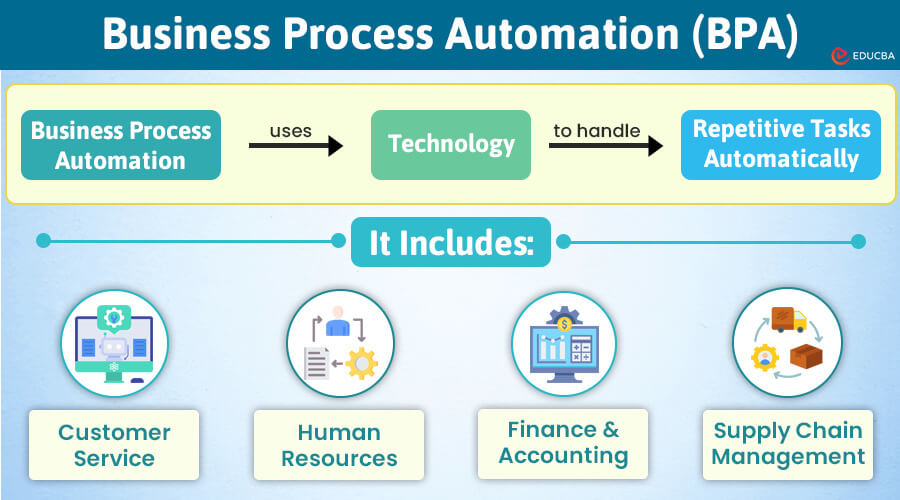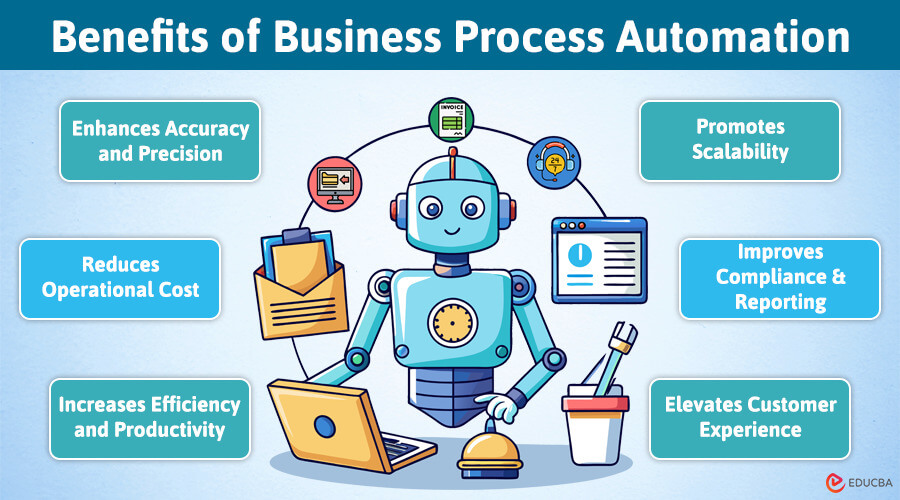
What is Business Process Automation?
Business Process Automation (BPA) is the use of technology to handle routine and repetitive tasks automatically instead of manually. This means using software, systems, or process mining software to handle tasks like data entry, invoicing, or customer service so employees can focus on more important and complex work. BPA helps businesses work more efficiently, make fewer mistakes, and save time and money.
Benefits of Business Process Automation

The benefits of business process automation are:
1. Increases Efficiency and Productivity
Automation speeds up tasks, completing them much faster than manual methods. This lets employees concentrate on more important tasks, boosting productivity and fostering innovation.
2. Reduces Operational Cost
Automating workflows reduces operating costs by eliminating unnecessary manual steps and errors. For instance, automating invoicing or payroll can save time and reduce late fees, leading to significant cost savings.
3. Enhances Accuracy and Precision
Manual processes are likely to have mistakes, which can lead to inconsistencies. Automation ensures tasks are done accurately and consistently every time, especially in data-heavy processes where precision is crucial.
4. Promotes Scalability
As businesses expand, their operations can become more complex. Automation systems can handle growing workloads and more intricate processes without affecting productivity, making it easier to scale up.
5. Improves Compliance and Reporting
Automation helps maintain compliance with industry regulations by keeping accurate records and generating timely reports. This lowers the chances of breaking the rules and facing fines.
6. Elevates Customer Experience
Automating customer service tasks, like responding to inquiries and processing orders, leads to faster and more reliable service. This improves customer satisfaction and loyalty, which are essential for long-term success.
Steps to Implement Business Process Automation
The steps for implementing business process automation are as follows:
Step 1: Identify Automation Opportunities: Look for repetitive tasks that take up a lot of time and are prone to errors. Common examples include data entry, payroll, customer support, and inventory management.
Step 2: Choose the Right Tools: Select automation tools that match your needs. Check their features, ease of use, how well they work with your current systems, and if they can grow with your business.
Step 3: Create a Clear Plan: Develop a detailed plan for implementing automation. Outline the steps, assign tasks, and set deadlines. Make sure everyone involved understands the plan and the benefits.
Step 4: Train Your Team: Train your employees to use the new automation tools effectively. Proper training helps them adapt to the changes and use the system correctly.
Step 5: Monitor and Improve: After implementing automation, monitor its performance and gather user feedback. Use this feedback to make necessary improvements and keep the system running smoothly.
Real-world Applications of Business Process Automation
The real-world applications of Business Process Automation are:
1. Customer Service
Tools like chatbots and automated email responses can quickly answer common customer questions. This lets customer service reps handle more complicated issues, speeding up responses and boosting customer satisfaction.
2. Human Resources
Automation in HR, particularly in tasks like hiring, payroll, and performance reviews, significantly enhances the efficiency and accuracy of these operations. This, in turn, allows HR staff to dedicate more time to crucial activities such as talent development and employee growth management.
3. Finance and Accounting
Automation helps finance departments handle payment processing, expense tracking, and financial reporting. By using accounting automation software, organizations can reduce errors and ensure financial reports are accurate and timely.
4. Supply Chain Management
Automating supply chain tasks like inventory management and order processing smooths operations and cuts costs. It helps maintain inventory levels and ensures timely delivery, reducing stock shortages and logistics expenses.
Final Thoughts
Implementing automation needs careful planning and the right tools, but the benefits are worth it. Business process automation can change how your company works by boosting productivity, cutting costs, and improving accuracy.
FlowForma offers digital process automation solutions that help growing businesses optimize their operations. While this blog highlights the general benefits of automation, FlowForma’s platform helps organizations achieve their automation goals effectively.
Recommended Articles
We hope this guide to business process automation was helpful. Explore these articles to improve your understanding of automation.
